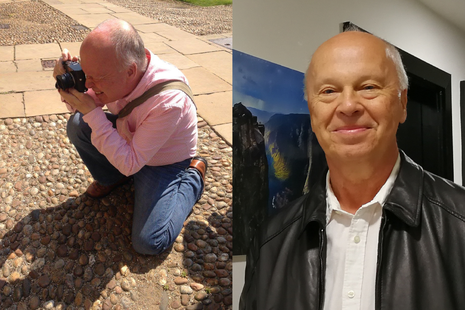A snapshot of Paul Ashley: sitting down with Camdram’s in-demand photographer
Jennifer Chen turns the lens on amateur photographer (and retired geologist?) Paul Ashley, uncovering the multi-faceted man behind the camera

Spend any time in Cambridge theatre and you’ll come across the vivid work of retired environmental scientist, grandfather, and beloved photographer Paul Ashley. Before finding shots on the ADC stage, Paul was living for months at a time in countries across Africa, the Middle East, and Southeast Asia as a geologist, locating and researching underground water. In some ways, the many lives he’s lived remind me of Barbie: there’s Paul the geologist, Paul the owner of a company, Paul the environmental manager. Shockingly, the life of Paul the photographer did not begin in earnest until much more recently.
Sitting down with the man himself, Paul tells me he’s been taking photos his whole life, but didn’t start performance photography before being asked to capture shots of his choir (by the way, he’s also an amateur musician!). After that, he started taking pictures for local Cambridge productions by Corkscrew Theatre and BAWDS. One Trinity garden show and a CUMTS musical later, Paul was catapulted by word of mouth to the position he enjoys now. At the end of his second year shooting student theatre, his work has become a true staple of the scene.
“Paul is not the only photographer in Cambridge, but he is perhaps the most consistent”
I ask what he enjoys about student theatre in particular. He tells me he likes taking pictures of people “doing things they’re good at”. It’s exciting to see people who are “clearly doing it because they thoroughly enjoy it”. The same could be said about Paul himself: it’s clear that he loves what he does.
Paul’s approach is reactive and adaptive. He maps out his method to me – how he watches shows he’s photographing, sometimes “stopping” his ears and absorbing it visually, but also taking the story into account. His concerns are twofold – there’s the need to take an “interesting” photograph, but also to grasp the spirit of the production. Paul sees rehearsals without all the bells and whistles, and so with little wider context, he primarily relies on dialogue. I ask him about the process of capturing the specific essence of each show, and he happily tells me about how he finds the currents of a plot through careful listening, then tries to demonstrate an interaction (“a threat, an emotion, something relevant”) through framing.
Paul is not the only photographer in Cambridge, but he is perhaps the most consistent. He points out that, on the ADC theatre walls, you’ll find photos from him and Johannes Hjorth (who left Cambridge years ago). “It’s sad that there’s nobody else”, he tells me. Perhaps this is unsurprising – there’s no shortage of barriers that budding photographers must overcome. For example, students largely do not have the means to amass high-quality equipment, unlike Paul, who shows up to each shoot with a beautiful selection of gear (“my cheat”, he chuckles at me).
“The power of a photograph can go beyond getting a few more bums in seats”
But it would be amiss to suggest that Paul stands in opposition to student photography. “I’m not trying to push myself in to do all of it”, he tells me. He jokes that he has “a lot of expensive equipment which does the work for me” but insists that students should not feel limited by lack of it: “I would be happy doing it if I had just a phone”. It’s creativity and hard work that make the photographer, and not necessarily what gear they have. It’s still tough to be a newcomer, but Paul muses that the only solution is to “just do it”. He speaks with optimism about what more student photographers could bring to the scene, pointing to Jessi Rogers’s distinctive perspective on subjects, or Charlotte Conybeare’s unique film photography.
“I really would like to see more student photographers”, Paul says earnestly. I agree. Amidst ongoing conversations about how to make the theatre scene truly inclusive is the discussion about diversity of perspective. The camera is another eye watching the stage, and we need to think more about that eye. In the CUADC race forum last term, concerns were raised about how photographers struggle to capture black and brown skin tones accurately. The solution to this isn’t simply more photographers, but greater attention to photography as part of the theatre-making process may help ensure that being able to capture all skin tones is simply a given.
After all, the power of a photograph can go beyond getting a few more bums in seats. Paul notes the remarkable pace at which this place churns out productions compared to the six-month or so rehearsal periods of the city productions. To slow down real life and channel all that energy and hard work into one single image is a special thing. Lines will leave the actors minds; techies will forget the insane last-minute requests from stressed directors; directors will stop being haunted by their productions in their sleep, but the photographs remain. So too will the legend of Paul Ashley.
 Arts / Plays and playing truant: Stephen Fry’s Cambridge25 April 2025
Arts / Plays and playing truant: Stephen Fry’s Cambridge25 April 2025 News / Candidates clash over Chancellorship25 April 2025
News / Candidates clash over Chancellorship25 April 2025 Music / The pipes are calling: the life of a Cambridge Organ Scholar25 April 2025
Music / The pipes are calling: the life of a Cambridge Organ Scholar25 April 2025 Comment / Cambridge builds up the housing crisis25 April 2025
Comment / Cambridge builds up the housing crisis25 April 2025 Comment / Pick an exam format and stick to it25 April 2025
Comment / Pick an exam format and stick to it25 April 2025






